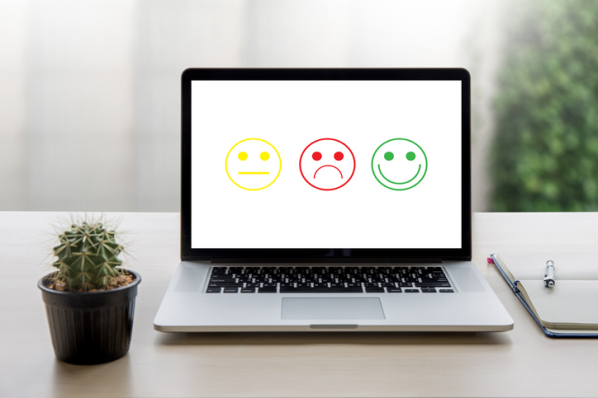As a touring musician myself, I know the stresses of the road and the peace of mind that washes over me when I arrive to soundcheck to find quality, well-maintained gear already set up on stage. I aim to recreate that experience for every client, but how do I know if I’ve hit the mark?
That’s where Net Promoter Score (NPS) comes in. NPS is a customer satisfaction metric that asks how likely a customer is to refer you to a friend. It’s a simple but honest metric that tells me how I’m doing, which is why I include it in every post-gig customer survey.
In this post, I’ll break down what NPS is, how to calculate it, and how to turn that score into actionable insights for improving the customer experience.
Table of Contents
- What is Net Promoter Score (NPS)?
- How to Calculate NPS
- How to Measure NPS
- HubSpot's NPS Score Calculator
- What does NPS mean?
- NPS Survey Types
What is Net Promoter Score (NPS)?
Net Promoter Score (NPS) is a simple but powerful way to measure how likely your customers are to recommend your product or service to others. It's one of the most popular customer success metrics due to its simplicity and effectiveness. With one question, I can gather a score that represents how my customers really feel about my business.
Here’s the question:
“On a scale of 0-10, how likely are you to recommend [company/product] to a friend or colleague?”
Based on their responses, customers are categorized into three groups reflecting their level of loyalty.
- Promoters (9-10): Your most loyal customers who will actively spread the word about your business through word-of-mouth.
- Passives (7-8): Satisfied customers who are yet to be converted to brand ambassadors. They are unlikely to badmouth you, but they aren’t writing home about you either. They are susceptible to your competition.
- Detractors (0-6): Unhappy customers who are likely to damage your brand through negative reviews and word-of-mouth, and churn.
NPS takes these individual responses and turns them into a single score that represents customer health, which is helpful in flagging issues early and measuring the impact of your changes to the customer experience.
Calculating NPS is simple. Once you’ve collected all your responses, all it takes is a little math to unveil the magic number. Don’t worry, if you’re not a math person, virtually every customer success management platform will do the calculation for you.
Net Promoter Score Formula
Here's the formula for NPS:

Or, for a more visual representation, use this handy graphic.

NPS Example
Let’s break this down with an example.
Imagine I surveyed 100 customers after a huge festival gig (I wish!) and the results were as follows.
- 70 promoters (scores of 9-10)
- 70/100 = 70%
- 10 passives (scores of 7-8)
- 10/100 = 10%
- 20 detractors (scores of 0-6)
- 20/100 = 20%

To calculate my NPS, I subtract my percentage of detractors from my percentage of promoters. In this case, 70% - 20% = NPS of 50.
How to Measure NPS
I’ve covered the NPS formula, but let’s dive a little deeper into the step-by-step process of getting those numbers. It all starts with a simple survey, but there's more to it than just asking the question. You’ll need to know when to ask, how to categorize responses, and how to crunch those numbers to turn them into valuable insights.
1. Survey your customers.
“On a scale of 0-10, how likely are you to recommend us to a friend?”
That’s the important question. There are a few ways to phrase it, but as long as the result is a number from 0 to 10 representing the customer’s likelihood to recommend you, you’re collecting NPS data.
Pro tip: After the NPS question, I like to add an open response text field where I encourage customers to explain their score. It’s helpful to gather qualitative feedback alongside the numbers to really understand what I’m doing well and what I can improve. The number tells you how the customer feels, and their comments reveal why.
Below is an example of a classic NPS survey I received after my recent trip to CVS to pick up a comically long receipt. You’ll notice that the phrasing of the question doesn’t explicitly call out a 0-10 score, but the scale below makes it clear.

Another thing to consider is the timing of your NPS survey. CVS sent me this NPS email shortly after I visited the store and made a purchase. The same logic applies to my business as well. It makes no sense for me to survey customers I haven’t worked with in months. Instead, I’ll send out my NPS survey the day after a successful gig, when the customer’s experience is still fresh in their mind.
Top tip: Use HubSpot's Customer Feedback Software to truly understand your customers with custom surveys and feedback tools. Create tailored surveys with diverse question types and a customizable template. Distribute them via web link or email, and share the insights with your team.
2. Categorize their responses.
Once you've received your survey results, it’s time to break them down into the three groups I mentioned earlier.
- Promoters (9-10): Your biggest fans and unofficial brand ambassadors. They’re already hyping you up to friends and family and probably leaving glowing reviews online.
- Passives (7-8): Satisfied but not delighted customers. They aren’t creating dedicated Reddit pages for your brand, but they aren’t talking trash either.
- Detractors (0-6): Unhappy customers who might leave bad reviews, churn, or Tweet mean things about you.

In this step, I’m simply sorting the responses. The math comes next, but you’ve gotta believe me, it’s not bad (I’m not a math guy.)
3. Find the percentage of promoters and detractors.
Now that your responses are nicely categorized, it’s time to do a little math. What I’m looking for is the percentage of respondents that are promoters and the percentage that are detractors. Passives don't factor into the NPS formula; I’ll touch on that below.
Here’s how to do it:
- Take the number of promoters, and divide it by the total number of responses. Multiply that by 100 to get your percentage.
- Do the same for detractors.
For example, let’s say I surveyed 100 customers and got 70 promoters and 20 detractors.
- 70 promoters / 100 responses = 0.70. Multiply that by 100 to get 70% promoters.
- 20 detractors / 100 responses = 0.20. Multiply that by 100 to get 20% detractors.
That’s it, not so bad, and we’re just one step away from the final NPS score.
Note: You might wonder why I ignore the passives.
Because passives are neutral in terms of loyalty, and NPS is meant to measure promoter energy vs detractor risk. Passives don’t lean either way, but that doesn’t mean they aren’t important.
Passives are the easiest to convert into promoters with just a little extra effort. I always pay close attention to what this group has to say, which is why I include an open-response field in my NPS surveys. Using those insights, I can identify the small details that transform satisfied customers into delighted ones.
4. Calculate the score.
We made it to the home stretch. Now that we have the final percentages, all we need to do is subtract the percentage of detractors from the percentage of promoters, and we’ve got our Net Promoter Score. As per our example above:
- 70% promoters
- 20% detractors
70 - 20 = 50
Boom, our NPS is 50.
50 is a decent score. NPS can range anywhere from -100 (every respondent is a detractor… ouch), to +100 (every customer is a promoter… legendary.) Anything above 0 means you’ve got more happy customers than unhappy ones. Anything above 50 and I know I’m on the right track.
With a score of 50 on the nose, I’m not panicking, but I know it's time to start working on converting my passives to promoters and addressing whatever is upsetting my detractors.
HubSpot's NPS Score Calculator
If doing the math manually seems like a drag, HubSpot’s free Customer Service Metrics Calculator is here to save the day.
It’s a simple tool that helps you calculate NPS (and other key service metrics) without having to create a spreadsheet from scratch.
Download: HubSpot's NPS score calculator
I loved that I could drop the calculator into my Google Sheets with one click. The spreadsheet is clean and well-formatted, and I appreciate the separate tabs for various customer service metrics.
All I had to do was add my data to the corresponding fields, and the sheet does the work for me using built-in formulas.
Here’s how I do it:
1. Collecting Data
When I get results from a recent customer survey, all I have to do is pop them into the calculator. No need to divide by total responses and get percentages; the sheet does that for me.
For this run through, I chose to stick with the example from earlier: 70 promoters, 10 passives, and 20 detractors.
2. Entering Data
I plug those numbers into the calculator: 70 for promoters, 10 for passives, and 20 for detractors. The tool automatically tallies the total number of responses and crunches the numbers on my behalf. Thank you, Mr. NPS Calculator.
3. Calculating the NPS Score
With the data entered, the calculator instantly shows my NPS. Just like in our example above, the result is an NPS score of 50.

So, I’ve discussed how to calculate NPS at length. By now, we’re all experts at turning survey responses into an NPS score. But what makes that score an actionable insight? What do we do after we’ve uncovered the magic number?
What does NPS mean?
You’ve got your NPS score. Cool. But what now?
Getting your NPS score isn’t the end goal. It’s just the beginning. Here’s what I’m thinking about in response to a fresh NPS score.
1. Are my customers satisfied, or are they at risk of churning?
My NPS score is like a health check on customer loyalty and satisfaction. A high score (50 and above) is great. It means the majority of my customers are singing my praises, which usually means they’ll spend more, refer friends, and stick around for the long haul.
On the other hand, a low NPS score indicates that something is amiss. Not only are customers unhappy and potentially likely to leave, but it also means they could be bad-mouthing your business online and in person, preventing potential customers from ever walking through your door.
I’ve learned the hard way that one unhappy customer can snowball into a mess of lost revenue if you don’t catch it early. For example, I once had a customer who was disappointed that the guitar they rented from me didn’t have fresh strings on it. Very fair. Now, every guitar head out the door with a fresh set, no exceptions.
2. How are my customers' opinions trending over time?
NPS isn’t just a one-time metric. The real value comes into play when you track NPS over time. That’s how I can see the bigger picture of customer satisfaction and how it’s affected by business decisions I make.
When I first started Tri-State Backline, I didn’t have a lot of inventory, and specifically, I lacked proper road cases for transporting amps. Once I invested in sturdy, professional-looking road cases with custom branding, my NPS scores started to go up. When I look back at charts, there’s a clear upward trend corresponding to the date I started sending out amps in the professional road cases that artists and venues expect.
3. What changes do I need to make?
My NPS score is like a Bat Signal; it lets me know when something needs attention (or that everything is going smoothly if the score is high).
The number itself doesn’t give me any context, though. If I notice there’s a downward trend in NPS, I know there's work to be done. But what?
That’s where qualitative feedback comes in, and it’s why I recommend collecting written feedback alongside NPS data, because it tells the whole story behind your data.
That’s how I ended up upgrading my amp cases. Not only did I notice that my NPS score wasn’t where I wanted it, but more than one customer left comments saying they expected their rental amp to arrive in a professional road case, and well, it didn’t. I made the upgrade, and the feedback and NPS scores have improved since.
NPS Survey Types
There are two types of NPS surveys based on when and how they're sent to customers: Relationship and Transactional.
Relationship Surveys
Relationship NPS surveys are recurring check-ins. You can send this type of survey out on a regular schedule, such as monthly or quarterly, to gauge how customers are getting along over time.
For example, when I worked at HubSpot, customers were assigned a dedicated Customer Success Manager to help them get the most out of the product. Since HubSpot is a SaaS business with long-term customer relationships, it makes sense for CSMs to send relationship NPS surveys on a schedule.
Think about it, it wouldn’t make sense for HubSpot to send out an NPS survey the minute someone signs up. With a product like HubSpot, it makes sense to survey NPS regularly to track how the customer experience evolves as they incorporate the product into their tech stacks and use it to run their businesses.
Transactional Surveys
Transactional surveys are triggered by specific events in the customer lifecycle, like after a purchase, a customer service interaction, or a period of inactivity.
I use transactional NPS surveys by personally reaching out to customers after a gig where they rented my gear. That way, I’m gathering feedback related to a specific and recent customer experience.
Another typical example is when you shop at a chain store like Chipotle or CVS and get an email survey shortly after. In cases like that, they’re most likely using CRM software to trigger an NPS survey right after purchase.
Pro tip: Timing matters. I don’t send an NPS survey the moment a customer reserves an amp or drum kit. I wait until after the gear has been used at the show and returned to my possession.
Ideal NPS survey timing depends on your business, but it's best to wait until the customer has fully completed their interaction with you. You want to wait long enough that your survey isn’t intrusive, but not so long that the experience fades from memory.
Relationship vs. Transactional NPS surveys
The difference between relationship and transaction NPS surveys comes down to timing and intent. Here’s the breakdown:
- Relationship NPS surveys measure overall customer sentiment over time.
- Transactional NPS surveys measure satisfaction with a specific customer experience.
Both types of NPS surveys are valuable, and many businesses can benefit from both strategies.
Transactional surveys help you act on specific feedback right away, while relationship NPS surveys give you a broader view of how your customer experience is shaping up over time.

Use NPS to bolster customer relationships.
If there’s one thing I’ve learned as a support rep at HubSpot, member of a touring band, and owner of a small business, it’s that customers will tell you how you are doing. You just have to ask.
When I worked at HubSpot, they really drilled the customer-obsessed mindset into my head, and it’s been a guiding light throughout my career. Being a business owner is challenging. Things often feel uncertain, and it’s hard to know where to focus my energy. However, working on this article reminded me that customers always have the answer. If you’re shaping your strategy around their needs and feedback, you’ll always be headed in the right direction.
That’s why NPS is so important. It’s one of the simplest ways to catch red flags early, hone in on customer sentiment, and act with clarity towards their best interests.
Whether you’re running a local gear rental business or managing thousands of customer relationships, NPS is a way to give customers a voice. It’s up to you to listen.
Net Promoter, Net Promoter System, Net Promoter Score, NPS, and the NPS-related emoticons are registered trademarks of Bain & Company, Inc., Fred Reichheld, and Satmetrix Systems, Inc.
Editor's note: This post was originally published in July 2017 and has been updated for comprehensiveness.
NPS








.jpg)




![NPS Question: The Secret to Getting It Right [+ 5 Best Practices]](https://53.fs1.hubspotusercontent-na1.net/hubfs/53/nps%20question_featured-1.jpg)
